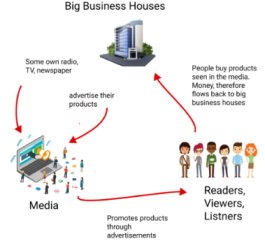Understanding Media Questions and Answers - Free PDF Download
FAQs on NCERT Solutions For Class 7 Social Science Social And Political Life Chapter 6 Understanding Media - 2025-26
1. How do the NCERT Solutions for Class 7 Social Science Chapter 6 help in preparing for exams?
The NCERT Solutions for Class 7 Social Science Chapter 6, 'Understanding Media', are designed by subject experts to provide clear, step-by-step answers for all the textbook questions. They help you understand how to frame answers correctly as per the CBSE 2025-26 guidelines, ensuring you cover key concepts like the role of media, technology, and democracy, which helps in scoring better marks.
2. How do the NCERT Solutions for Chapter 6 explain the concept of a 'balanced report'?
According to the NCERT Solutions, a balanced report is a news story that discusses all points of view of a particular story and then leaves it to the readers to make up their minds. The solutions provide model answers that demonstrate how to present different perspectives neutrally, which is essential for questions on media ethics and responsibility.
3. What is the correct way to answer questions about 'independent media' as per the NCERT Solutions for Class 7 Civics Chapter 6?
To answer correctly, you should state that an independent media is one that is free from the control and influence of any external power, including the government or large business houses. The NCERT solutions guide you to explain that this independence is crucial for providing a balanced report, and they often provide examples of how this independence can be compromised by censorship or business interests.
4. Are the Vedantu NCERT Solutions for Class 7 Social Science Chapter 6 updated for the 2025-26 session?
Yes, the NCERT Solutions are fully updated to align with the latest CBSE syllabus for the 2025-26 academic year. Our subject matter experts continuously review and revise the solutions to ensure they strictly adhere to the current curriculum and marking schemes, providing you with the most relevant and accurate study material.
5. Why is it important to use a step-by-step method, as shown in the NCERT solutions, when explaining the link between media and technology?
Using a step-by-step method is crucial because it breaks down a complex topic into simple, logical parts. The NCERT solutions demonstrate this by first explaining how changing technology helps media reach more people (creating 'mass media'). Then, they explain how technology impacts the cost and quality of broadcasting. This structured approach ensures your answer is comprehensive and easy for examiners to follow, which can lead to higher marks.
6. How do the NCERT Solutions help differentiate between 'setting agendas' and 'censorship' for exam answers?
The NCERT solutions clarify that these are two distinct concepts. Setting agendas refers to the media's power to influence our thoughts by focusing on particular stories and shaping public opinion. In contrast, censorship refers to the government's power to prevent media from publishing or showing certain stories. The solutions provide clear definitions and examples for both, helping you to write precise and distinct answers in your exams.
7. How can a student use the NCERT Solutions for Chapter 6 to frame a high-scoring answer about the media's role in a democracy?
You can use the NCERT solutions as a template for structuring your answer. The solutions typically break down this important topic into a clear, bulleted format. For a high-scoring answer, you should include these key points:
Providing citizens with information about national and international events.
Facilitating public debate and discussion on important issues.
Holding the government accountable for its actions and policies.
Forming and reflecting public opinion.
Following this structure helps cover all essential aspects of the question.
8. According to the NCERT solutions, what is the link between media and money?
The NCERT Solutions for Chapter 6 explain that the technology used by mass media, like TV studios and transmission satellites, is very expensive. To cover these costs, media houses rely heavily on advertising. This connection between media and money often influences the content that is broadcast, as media outlets may prioritise stories that attract advertisers or avoid those that criticise them. The solutions help you explain this commercial aspect of the media in your answers.

















